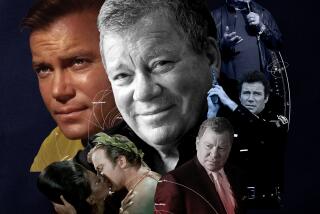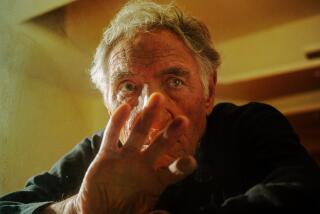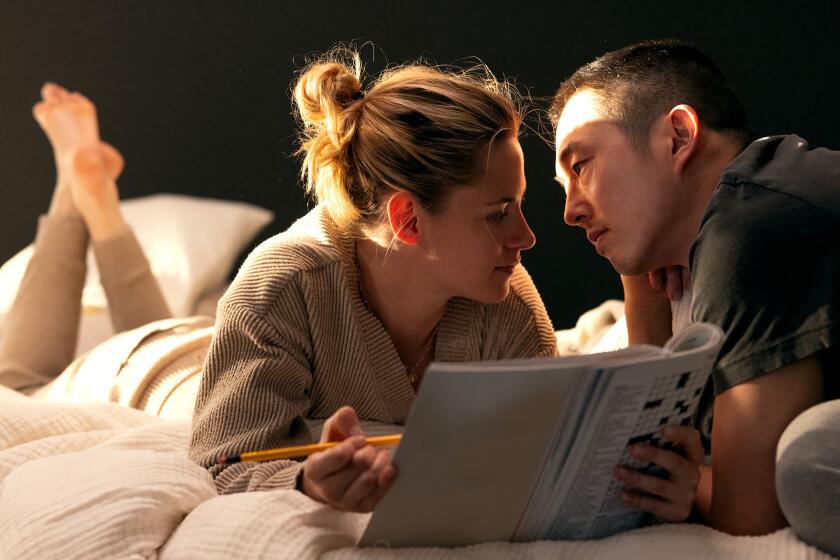Genndy Tartakovsky gets ‘Hotel Transylvania’ open for business
- Share via
“Hotel Transylvania,” an animated comedy about Dracula running a high-end resort for monsters, had already sucked the lifeblood out of five directors when Genndy Tartakovsky came aboard as director No. 6 in February 2011.
Tartakovsky, the Moscow-born creator of the Cartoon Network shows “Dexter’s Laboratory” and “Samurai Jack,” is an accomplished figure in the cozy world of TV animation. The cartooning equivalent of a live-action TV auteur like “Mad Men” creator Matt Weiner, Tartakovsky has been nominated for 13 Emmys and won three, and his kids shows have attracted a following among adults for their wit, action and style. Especially, he’s known for his distinctive, hand-drawn, cartoonish technique, at a time when so much computer-driven animation seeks to be hyper-realistic.
But though he has supervised hundreds of episodes in his 20 years of working in TV animation, Tartakovsky, 42, was unprepared in one key way for his first feature film — he had never experienced the enervating atmosphere of a project that has passed through many, many creators’ hands.
“I was the sixth man in, and it was like being dropped into combat,” Tartakovsky said recently at his office on Sony Pictures Animation’s Culver City lot. “This movie’s been worked for six years already and everybody’s kind of bitter.... I’ve never had so much resistance from everywhere — the studio, the artists. It took me a while to get my feet on the ground and win everybody over.”
“Hotel Transylvania” has had many renderings since its original directors, David Feiss and Anthony Stacchi, launched the movie at Sony in 2006. In Feiss and Stacchi’s take, the world had gotten too scary for monsters, and they retreated to the hotel.
“We had a great premise, but it was a premise — a hotel for monsters,” said Bob Osher, who came aboard as president of Sony Pictures Digital Productions two years into “Hotel Transylvania’s” development. “Earlier iterations never jelled to where everyone said, ‘This is the version of the story we want to make.’”
Tartakovsky’s movie, premiering at the Toronto International Film Festival Sept. 8 and hitting theaters Sept. 28, is a father-daughter story. Dracula, a fastidious hotelier and overprotective dad voiced by Adam Sandler, invites Frankenstein (Kevin James), the Mummy (Cee Lo Green), a werewolf (Steve Buscemi) and other monster friends to his resort to celebrate the 118th birthday of his adolescent daughter, Mavis (Selena Gomez). When a spirited young backpacker (Andy Samberg) inadvertently crashes the monster mash, Dracula must confront his fear of losing Mavis to the dangerous human world, as he once lost her mother.
In the high-stakes, $100-million-plus world of feature animation, many movies have a twisty back story — Pixar’s summer release, “Brave,” gestated for eight years and changed directors midstream. Typically, animated movies take at least four years to make, scripts linger longer than the executives who greenlight them and studios often switch directors, who are studio employees and have never been covered by the directors’ union.
Founded in 2002, Sony Pictures Animation has produced box-office hits like “The Smurfs” and “Cloudy With a Chance of Meatballs” at lower budgets than most of its competition, but films such as “Arthur Christmas” from its partnership with the British animation company Aardman Animations have underperformed. As five directors came and went on “Hotel Transylvania,” which has a budget in the $100-million range, pressure mounted to deliver an in-house success. In late 2010, Michelle Raimo-Kouyate was named president of production at the studio, and Tartakovsky signed onto the film soon after.
Osher, who thought Tartakovsky’s knack for physical humor would enliven the story, said he tried to lure the director to work at Sony for months with no success. Instead, Tartakovsky had been attempting to sell various studios on a “Samurai Jack” movie.
“I was thinking romantically,” said Tartakovsky, who has a blocky, Bluto-like build and a faintly Russo-Midwestern accent. “I wanted my first feature to be an original idea. But I spent the last five or six years trying to sell a movie and it wasn’t happening.... My TV reputation didn’t really cross over into feature animation.... There’s a level of respect that’s not there. It’s high pressure, a lot of money and then you have to work with voice actors.”
When Tartakovsky came aboard in 2011, Sandler had just signed on and Sony’s artists had created the movie’s environments, chiefly the Gothic castle that houses Dracula’s hotel. But Tartakovsky brought a signature visual idea — a stylized take on Dracula that owes more to the caricatured look of old Looney Tunes cartoons than it does to the hyper-real appearance of most modern, computer-animated films. Tartakovsky’s TV work has mostly been 2-D and hand-drawn, but like the vast majority of animated studio movies, “Hotel Transylvania” is 3-D and computer-animated.
Tartakovsky’s monsters stretch, squish, hover and crouch in ways that challenge computer software that was designed to replicate the real world. In meetings with the “Hotel Transylvania” animators, the director drew over frames of the film on a digital tablet and acted out desired poses — Dracula hunched under his cape, for instance. For animators working within the constraints of a CG model, the wildly expressive shapes created problems.
“The animators would be very tentative,” said “Hotel Transylvania” producer Michelle Murdocca. “No one would ever say ‘no,’ but they had to go back and figure out if they could really do what he was asking for.”
For Tartakovsky, the exaggerated poses are the whole point of working in animation to begin with — cartoons, he believes, should actually be cartoonish. “I took all the aesthetics I like from 2-D and applied them here,” he said. “I don’t want to do animation to mimic reality. I want to push reality. You want to have your own identity. You don’t want to have an expression that Pixar has. That was super important to me. In 2-D, the way you draw defines you, but in CG the computer takes away your identity. I wanted to make sure the movie had my point of view.”
Drawing from experience
As a kid, Tartakovsky learned English from Bugs Bunny cartoons and began to create his own cartoon flip books, selling them to classmates for a quarter. He had moved to the U.S. from Russia at age 7, first living in Columbus, Ohio, and then Chicago. His father, Boris, a Jewish dentist for the Russian hockey team, was worried that anti-Semitism in Russia would cloud the future for Genndy and his brother.
“I loved drawings,” Tartakovsky said. “Loving that to begin with and watching it move. That captured my imagination — how to make this thing come alive. And the next level was actually doing something and having a kid laugh at it. It was a way of doing my own stand-up comedy. I didn’t have the verbal skills to be funny. I wasn’t even very good, that was the funny part. I wasn’t talented in any way.”
After two years of studying film at Columbia College Chicago, Tartakovsky transferred to the elite animation program at the California Institute of the Arts, where he met “Brave” director Mark Andrews, who would later work as a storyboard artist on Tartakovsky’s shows “Star Wars: Clone Wars” and “Samurai Jack.”
“There’s very little dialogue in a Genndy show,” said Andrews. “It’s pure visual storytelling. That’s the great thing about Genndy that we don’t see in animated features.”
Tartakovsky’s first film at CalArts was a silent 41/2-minute movie called “Muffy Meets the Mafia” about a cat who saves a dog and then can’t shake the grateful canine. It was also at CalArts that he began creating the show that would become the Cartoon Network’s first original hit — “Dexter’s Laboratory,” about the adventures of a boy genius.
In TV animation, much of the work is produced overseas for cost reasons. At the Cartoon Network, Tartakovsky worked with animators in South Korea and launched a new episode every two weeks.
“He’s directed a lot of episodes,” Osher said. “He’s very experienced. Animation directors in the feature space just don’t have as much opportunity to develop. Having that experience gives you a certain amount of confidence and a sure hand. He knows how to talk to the crew. He knows what he wants. In the TV space, the time window is very dense so you have to make decisions. You have to be very disciplined.”
Tartakovsky said he played his experience card often on “Hotel Transylvania” — to persuade the crew to try his 2-D style, to persuade executives to follow his story impulses and to sell Adam Sandler on some visual jokes.
“You’re the chef,” Tartakovsky said. “You’re hired ‘cause they like the taste of your soup. You start cooking and they go, ‘No, no, no more salt, take out the chicken.’ And you’re like, ‘But this is chicken soup.’ Really nobody’s wrong. It’s just all opinions. You’re coming into the situation thinking you’ve been hired because of your point of view.... All of a sudden my point of view is gone. So I feel like that’s where I fight.”
Though “Hotel Transylvania” doesn’t hit theaters for a month, Sony Animation has already signed a deal with Tartakovsky to develop two more movies. One will be an original idea of his (a family comedy) and the other a new take on “Popeye” — which he plans to make as artful and unrealistic as possible.
More to Read
Only good movies
Get the Indie Focus newsletter, Mark Olsen's weekly guide to the world of cinema.
You may occasionally receive promotional content from the Los Angeles Times.











